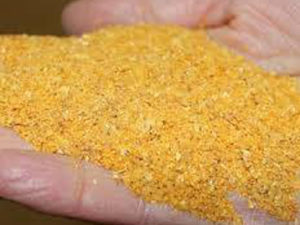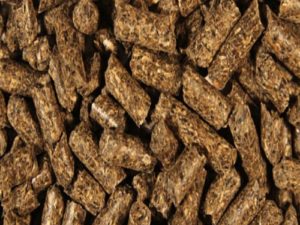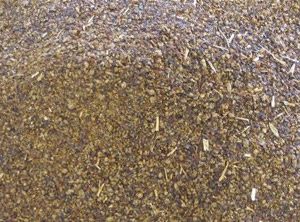Copra
Copra Meal – What is it?
Produced from the Coconut Palm (Cocos nucifera), Copra is the dried section of the meaty inner lining of the coconut fruit. Ripe coconuts are split and laid in the sun to dry, with flame drying also used in some instances to aid in reducing moisture down to the required 14 per cent prior to additional processing.
The principle process of extracting coconut oil from the meat is achieved within an ‘expeller’ press where the dried coconut flesh is subjected to pressurised steam and mechanical rollers to express the coconut oil. The resultant product is the copra expeller meal.
Copra meal is generally a light to dark brown colour being reflective of where the coconut trees are grown, climate, soil type and extraction method. The extraction method refers to either single or double expeller extraction, the later removing more of the coconut oil and therefore increasing the protein level as a percentage of the meal.
The aggregate is generally a fine meal, thus allowing the copra meal to readily travel through all feed dispensing systems.
Copra carries a pleasant odour which stock find highly acceptable, the aroma also has the benefits of being able to mask taints associated with anionic salts (i.e. magnesium products) which may be used during certain times of the year as part of a farm management policy.
Typically copra meal is sold for sale under the following specifications:
| Dry Matter: | 90% |
| Crude Protein: | 18-22% |
| ME: | 12-14% (Mj ME/.kg Dry Matter) |
| DE: | 15 (Mj ME /Kg DM) |
| Oil | 8% (ether extracts) |
| Starch | 1.3% |
| Fibre | 33% (Acid Detergent Fibre – ADF) |
| By-Pass Protein: | 70% |
There are three key attributes contained within copra meal which makes it superior to almost all other economically viable supplementary feeds. Firstly, the by-pass protein level ensures that the valuable protein level contained within copra is not degraded in the rumen but is absorbed further down the digestive tract to maximum effect.
Secondly, the energy supplied via copra is from its high oil content rather than starch as in most other grains (i.e. maize grain/silage, barley). This oil is ‘low heating’ minimising acidosis type metabolic problems occurring where the excessive build up of acid in the gut extends into the large intestines destroying the friendly bacteria population, leading to ongoing metabolic problems.
Thirdly, the well balanced nutrient profile gives copra meal the advantage of being able to be fed as a sole ration. Consequently it is superbly suited to blending with maize silage, balancing the high energy content of the maize silage with the oil content and protein profile of copra meal – effectively the protein deficiencies of maize silage, most importantly that of the amino acid L-lysine are corrected. L-lysine being intimately related to milk production more specifically milk fat production.
| Typical Amino Acid Profile: | Fatty Acid Profile | |||
| Alanine | 8.9% | Lauric | 40% | |
| Arginine | 25.0% | Myristic | 20% | |
| Asparagine | 15.6% | Palmitic | 13% | |
| Cystine | 8.0% | Oleic | 12% | |
| Glutamine | 26.2% | |||
| Glycine | 8.4% | Mineral Content | ||
| Histidine | 3.6% | Magnesium | 0.36% | |
| Isoleucine | 6.2% | Sulphur | 0.26% | |
| Leucine | 13.0% | Potassium | 2.0% | |
| Lysine | 5.4% | Phosphorus | 0.5% | |
| Methionine | 3.9% | Calcium | 0.23% | |
| Phenylalanine | 8.7% | Sodium | 0.04% | |
| Proline | 7.2% | Iron | 83 (mg/kg) | |
| Hydroxyproline | 0.65% | Manganese | 46 (mg/kg) | |
| Serine | 8.8% | Copper | 33 (mg/kg) | |
| Threonine | 5.9% | |||
| Tryptophan | 2.0% | |||
| Tyrosine | 6.0% | |||
| Valine | 10.0% |
As a strategic feed copra is an excellent product that cost effectively helps fill feed gaps and maintains good cow condition particularly over the summer period and as cows come into cycle for reproduction. Many farmers cite that their ‘empty’ cow percentage dramatically reduces after using copra where it is used to keep condition on the herd prior to mating. Copra also has few of the negative attributes associated with other protein sources such as those now being linked to lucerne supplementation.
Copra should be considered a true supplement in that it does not substitute itself in favour of pasture, offering tremendous advantages over almost all other single ingredient feeds at its price level.
For further information on copra meal and its application we recommend that you download from the Organic Products website an Acrobat PDF file titled ‘Copra for Ruminants’ from the following address: www.organicproducts.com.au
Copra Meal – Applications:
Transition/Springer Feeding (21days pre-calving)
During the transition period New Zealand dairy cows can be deficient in by-pass protein and energy. Appetite is reduced and feeding bitter anionic salts can cause variable and low feed intakes below the cow’s requirements.
Cows are supporting exponential calf protein growth in the last month of pregnancy. This growth may be coming from the cow’s own reserves, in many cases this leaves the cow prone to ketosis and other metabolic disorders even pre-calving. Increased dry matter intake including using copra and grain can assist the cow at this time.
Copra has been used since 1999 to successfully improve early appetite, carry and “mask” taste of anionic salts and improve protein percent and yield in early lactation.
Copra can be used to balance maize silage that is fed especially to reduce high DCABs that can be come from the pasture. High DCAB values are detrimental to cow health such as milk fever and secondary metabolic problems. Sub-clinical problems can also prove more costly than clinical cases as there are usually more cows affected with the main cost coming from a loss in milk production.
Transition diets including maize silage (2-3 kg), copra (1-1.5 kg), by-pass fat (200 g), pasture (6-9 kg) have produced improved milk yields of 30% over previous season feeding strategies. Milk fever has been almost eliminated on such diets where anionic salts (Magnesium chloride and Magnesium sulphate) have been correctly supplemented. These feeding strategies have proved most successful with Jersey herds that are more prone to milk fever.
Feeding strategic supplements as described, allows better control and re-growth of limited pasture supplies during the transition phase.
- There is a high demand for nutrient dense protein and energy in this period.
- Rumen volume and cow appetite is shrinking and calf demand increasing.
- Future metabolic and health problems must be minimised by management in this period.
- Anionic salts are critical to reducing milk fever and secondary metabolics.
- Copra has the advantage of being a highly palatable carrier and “taste masker” for carrying anionic salts, which are bitter tasting.
- Copra supplies much needed protein and energy at this time.
- Copra supplies Magnesium, Phosphorus and Calcium among other vital trace minerals and vitamins.
Early Lactation to Peak Milk Production.
The average New Zealand cow and herd is seldom deficient in protein in this period where pasture represents 80-90% of the diet. Energy deficiency is the greatest and is made worse by the cow needing to rid excess pasture protein coming from the pasture. Extra energy is best supplied from a starch source (grain, maize silage). Fat energy coming from Copra and by-pass fat can be very useful but this should not be the only source. Starch energy is more valuable to the rumen microbes and rumen function.
The case for supplementing with Copra comes when stocking rate (over 3.5 – 4.0 per hectare) and per cow production (over 25-27 litres/2.2 kg milk solids at peak) are high. Cows producing 400 – 450 kg of solids and 1,100 – 1,200 kg per hectare or more will require some protein supplements through lactation.
Where high levels of maize silage are used to support high producing cows; Copra can be used to re-balance the overall diet, which is often deficient in by-pass protein and sometimes rumen degradable protein.
Reproduction and Fertility Improvement
Poor transition cow management will always result in more metabolic problems that cause lower milk volumes and milk solids and also poorer reproductive performance.
In a trial where two nearly identical herds were fed similar pasture quality and quantity, one herd was fed copra and anionic salts in the transition period. The difference in reproductive performance was improved to only have 3% empties versus 8% empties in the standard herd. The district average was around 7-8% in this particular season.
A combination of reduced metabolic problems; better nutrition and improved weight control are the key factors explaining this result.
Summer Management
Poor milking persistency from November onwards is a major problem in New Zealand. Pasture quality is poor and supply is reduced. Pasture protein, energy levels and digestibility is low while fibre levels are high. Heat stress and high fibre heat the cow up which depresses appetite. Cows are using protein off their back as an energy and protein source. This is highly inefficient. Fat levels coming from copra are the least heating of energy sources so appetite and weight are maintained in this stressful time. Protein in pasture can be as low as 9-13% where cows need 17% in this period. Copra contains 20% on a DM basis so copra ideally balances pasture at this time.
| Summer pasture is: | High in fibre |
| High in “Heat” production. Digesting fibre “heats up” cows. This causes lower appetite. | |
| Low in protein. Maybe 12-13% only. Cows need 15-16%. | |
| Low in energy, digestibility and moisture. |
| Copra is: | High in protein and by-pass protein |
| High in energy and digestibility | |
| High in “low heat” oil or fat. Keeps cows cooler! | |
| High in minerals, phosphorus, magnesium. | |
| High in dry matter content. |
Cows have a major tendency to lose weight in this period due to poor diet quality and quantity made worse by reduced appetite. High temperature and humid conditions will often cause serious losses in production and cow weight at this time.
Copra has been used with grass, cereal and maize silage in this period to carry cows and production through.
Diets using copra, grains, by-products, molasses, salt, urea and preserved supplements have been used very successfully to improve summer or mid and late lactation performance.
Better summer management is vital to increasing the days in milk from 230 to 270 days or better. Cows do not have to put on so much weight and hence pasture cover is not sacrificed trying to achieve both extra days in milk and weight gain at the same time.
Providing cows with a more consistent diet throughout lactation is essential to improving per cow performance in New Zealand. Extra effort and skill is required to do this.
Weight Management of Young Cows especially in Summer.
First and second calvers are being asked to gain excessive capital or mature weight in their first and second lactation. Much of this weight should have been gained before first calving ever began. It is critical to support these younger cows at all stages of lactation but especially during summer when low protein pasture will dramatically affect their growth potential, future performance and even survival in the herd.
Reproductive performance can be affected through this period if environmental and dietary requirements are not met or managed adequately.





